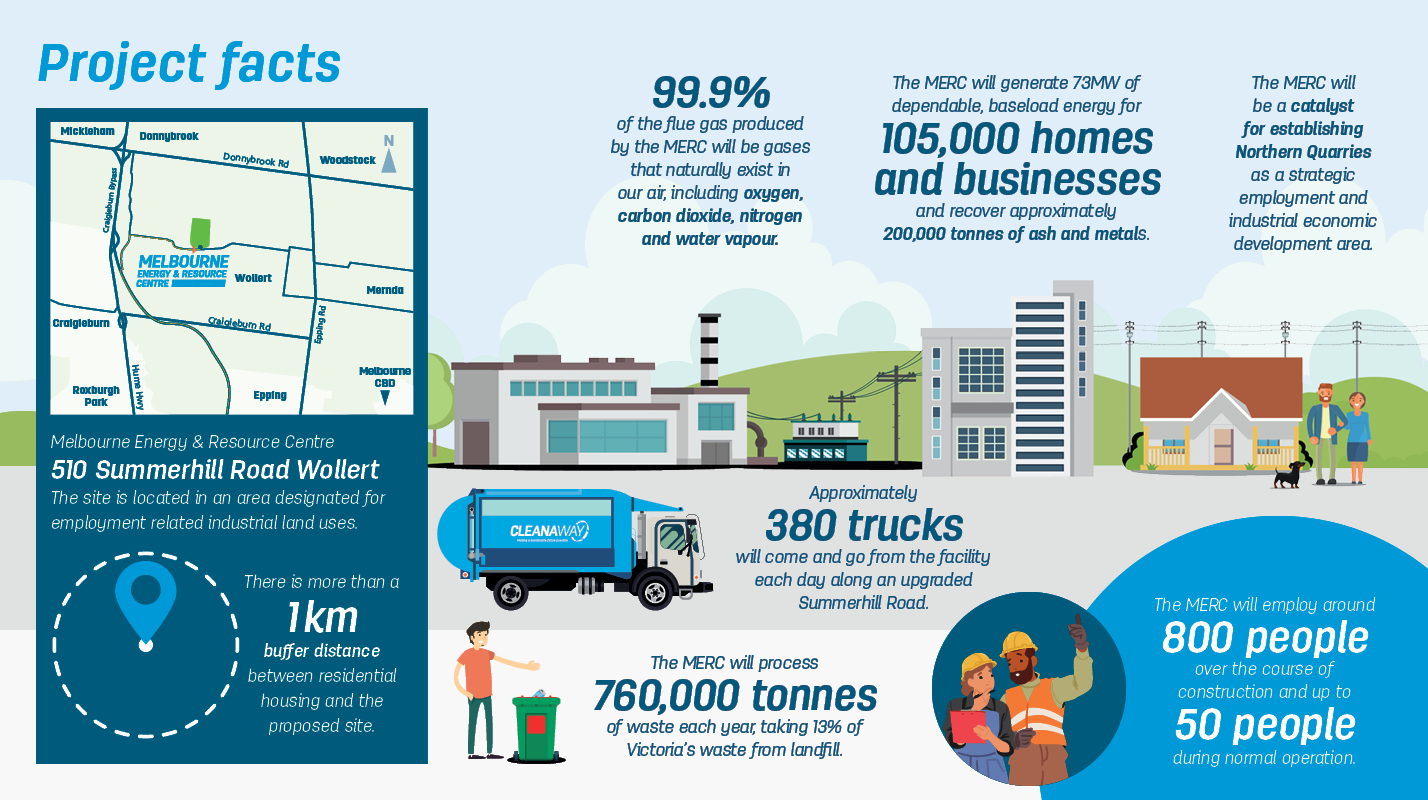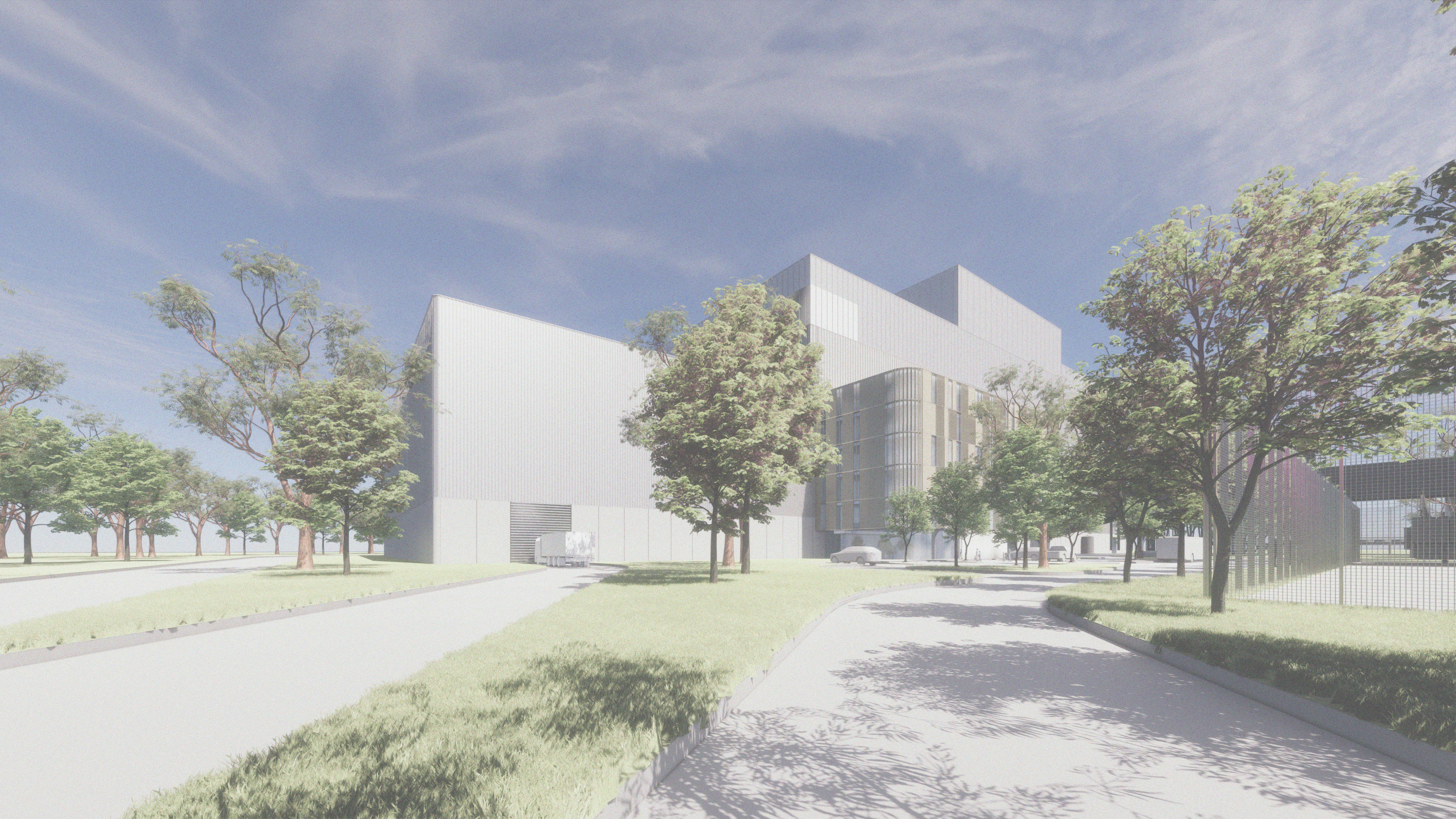About
Turning residual waste
into a local resource
The Melbourne Energy & Resource Centre (MERC) is designed to take residual waste that would otherwise go to landfill. It will create energy to power local homes and recover valuable materials such as Incinerator Bottom Ash and metals.
In August 2025, Cleanaway received a cap licence from Recycling Victoria allowing the Melbourne Energy & Resource Centre (MERC) to process up to 760,000 tonnes of residual waste each year.
In 2021 when the project was first proposed, Cleanaway considered a 380,000 tonnes per year capacity. This new increase makes the project more economically and operationally viable, allowing the MERC to deliver greater environmental benefits, lower waste management costs, and improved energy recovery at scale.
![]()
Why
Waste-to-energy is the solution for Victoria’s growing waste needs
Victoria is running out of landfill space.
Victoria needs a number of facilities across the State to support waste disposal each and every day. The total amount of waste for disposal (after resource recovery and recycling) is currently 5.7 million tonnes per year, which is projected to increase to around 8.9 million tonnes per year by 2053
That’s enough to fill almost 5,000 Olympic size swimming pools or 9.5 Melbourne Cricket Grounds (MCGs), every year.
We now face a critical choice: keep sending most residual waste to landfill, or reserve valuable landfill space for materials with no other treatment options.
* SOURCE: VICTORIAN RECYCLING INFRASTRUCTURE PLAN (VRIP), VICTORIAN GOVERNMENT, 2023 — WASTE PROJECTIONS MODELLING.

Project facts
Quick facts about the MERC proposal


Stakeholder Reference Group (SRG)
Engaging with the community every step of the way
The Stakeholder Reference Group (SRG) for the Melbourne Energy & Resource Centre (MERC) was established by Cleanaway in late 2023 in response to strong community interest and feedback gathered through earlier engagement activities.
Its purpose is to ensure a two-way dialogue where Cleanaway can share updates and receive meaningful input on the proposed MERC and formation of a Community Benefits Fund. As an advisory body, not a decision-making one, the SRG enables community members, local organisations and agencies to raise questions, identify local priorities, and reflect the diversity of views in the area.
The SRG plays an important role in promoting transparency, strengthening community partnerships, and ensuring that local voices are heard and considered throughout MERC’s development and operation.
If you are interested in joining the SRG, contact us at:
Direct (03) 9021 0603 and Email [email protected]
Learn more
Frequently Asked Questions
Find out the most asked questions about our proposal and the corresponding answers.
What is waste-to-energy?
How does it work?
Is it safe?
The proposal will use tried and proven moving grate combustion technology. Moving grate combustion technology is a flexible and robust technology that is best suited for processing mixed waste.
Click here to see how Gloucestershire Energy from Waste Facility (UK) uses this technology.
With over 100 years of operating experience, the moving grate combustion system is used in the majority of international waste-to-energy facilities and has a long track record of reliable operation recovering energy and other resources from mixed wastes.
Why does it need to be in Wollert?
Cleanaway assessed many potential sites across Victoria. Wollert was selected because it meets key criteria for a waste-to-energy facility. It’s located near waste sources like homes and businesses, reducing the need for long-distance transport and allowing energy recovery to be used locally.
The site aligns with planning policies supporting industrial and utility developments, is situated over 1 km from most residences to minimise impacts, and is next to quarries that limit other sensitive uses.
Its proximity to developing and established industrial areas offers potential local benefits and services. Additionally, the site has good road access via the Hume Freeway, with routes avoiding residential areas, supporting efficient truck movement. All these factors fit Victoria’s long-term waste management and environmental goals.
What impact will it have on the local community?
The Melbourne Energy & Resource Centre (MERC) will bring significant economic, community, and environmental benefits to Wollert and nearby areas. It is expected to create around 800 construction jobs and 50 long-term skilled operational roles, boosting local and regional employment. By providing a cost-effective alternative to landfill, the project helps stabilise waste disposal costs, potentially lowering Council rates for residents and businesses.
Cleanaway is establishing a Community Benefits Fund, managed by local representatives, to support initiatives like environmental projects, sporting facilities, and community recreation.
MERC will also feature a Visitor and Education Centre to engage the community in learning about recycling, resource recovery, and the circular economy.
How can Cleanaway be trusted to own and operate waste-to-energy facilities?
Cleanaway can be trusted to deliver a waste-to-energy facility because of our proven track record in large-scale waste management and resource recovery projects across Australia. We operate one of the country’s largest collection, recycling, and treatment networks, giving us the expertise and infrastructure to safely handle complex waste streams.
Our partnerships with leading industry and government stakeholders ensure projects are delivered to the highest safety, environmental, and compliance standards. With a focus on innovation and sustainability, Cleanaway is committed to providing reliable, long-term solutions that help reduce landfill reliance and recover value from waste.
Learn more
